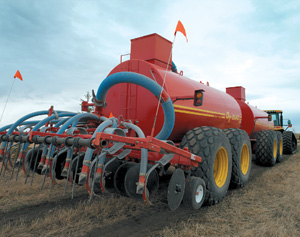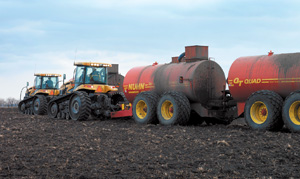
Utilizing Nuhn and Aer-Way
equipment—driven by Challenger tractors—the Scott family has
successfully diversified the family business into manure injection and
custom services with their company, Sno-Valley Manure Management.
Utilizing Nuhn and Aer-Way equipment—driven by Challenger tractors—the Scott family has successfully diversified the family business into manure injection and custom services with their company, Sno-Valley Manure Management.
When farmer Norm Scott and his son, Richard, developed a strategy to diversify the farm business to include custom manure management as a way to generate income to support two families, they believed they had a winning business plan. Their strategy was to attract business by specializing in manure injection.
If the volume of work that the company is attracting is any indication, their instincts were correct. By the middle of 2005, the company had tripled the amount of business it had done compared to last year.
The owners of Sno-Valley Manure Management of Red Deer, Alberta, definitely see themselves as forerunners in what has become an established trend in manure management: injection versus surface application of manure.
 A requirement to A requirement totransport manure greater distances to avoid over-saturation of farmland is one reason why Sno-Valley Manure Management upgraded to the MT765 Challenger Tractors. |
Scott says Red Deer County frowns on surface application, although it is permitted in situations where the ground is frozen and manure injection is not possible. There are many advantages to manure injection over surface application. With injection, there are no potential health hazards resulting from surface run-off, the manure’s nutrient value stays in the soil and there are no odor problems. In fact, the company calls itself, “The Neighbor Pleasers.”
“My view is that if you are a contractor and not injecting, in five to ten years down the road, you’re not going to be hauling anymore,” says Norm Scott. Norm and Richard started Sno-Valley Manure Management Ltd three years ago, and Norm’s son-in-law, Chris Burns, has also joined the business.
While Sno-Valley’s main customer base began with hog farms, the company now sees considerable growth potential from dairy farms because of the influx of Dutch dairy farmers into Central Alberta. Other areas of North America are witnessing a similar influx due to the high cost of farmland and limited opportunities for expansion in Holland.
Dutch immigrants and dairy farmers Gert and Jetty Niewenhuis moved to Central Alberta about the same time that Sno-Valley Manure Management started operating. They owned a dairy farm that milked 65 cows in Holland before moving to Canada, where they established a 100-cow dairy.
They have chosen to contract out their silage, grain, and manure management services, rather than trying to handle it themselves. “We’ve contracted out these services because running a dairy takes a lot of time and effort,” says Niewenhuis, “and having to purchase the equipment makes it too expensive to do ourselves.”
Because new arrivals like the Niewenhuis family are primarily focused on milk production, Sno-Valley Manure Management has successfully branched out into custom seeding, combining, and silage harvesting and delivery services. It has helped the company maintain cash flow between the busy spring and fall manure application seasons.
To help its farm customers maximize nutrient value from injected manure and to minimize odor, while maximizing business productivity, the company has invested in a highly effective manure management fleet.
Sno-Valley Manure Management has always used Challenger track-equipped tractors to pull its implements because they have superior flotation. The company recently purchased two new MT765 Series Challenger tractors.
The company’s manure management equipment fleet also includes two sets of Nuhn Industries tandem, 5,000-gallon tanks equipped with manure injection systems, an Aer-Way manure applicator for injecting manure on pasture and hay fields, and a smaller tractor to power the pump that sends the effluent from the lagoon to the transport tanks. Handling the pumping and agitation duties are two pumps, a Houle and a Nuhn.
On a typical job site, Sno-Valley’s smaller tractor powers an agitator and pump at the lagoon. The agitated liquid manure is pumped into the two manure tandem tanks, with the rear tank equipped with the injection system. It fits on to the rear tank like a three-point hitch cultivator.
The company does nearly all of its work using the Nuhn Industries S-TINE injector. It features staggered front coulters making it easier for the tractor to pull, staggered vibra shank injector teeth for efficient blending and distribution of manure in the soil, and a rubber boot, which distributes manure evenly in the ground. It also has a leveling harrow—which levels out the ridges and covers any manure that happens to be on the top—adjustable down pressure to follow the contours of the ground, and the ability to easily switch from spread plate to manifold. It comes in both a nine-tooth or 11-tooth model.
 Injection application of manure is the way to go, says Sno-Valley’s Injection application of manure is the way to go, says Sno-Valley’sNorm Scott. “If you are a contractor and not injecting, in five to ten years down the road you are not going to be hauling anymore.” |
“It works like an air seeder,” says Scott. “The manure goes through a set of hoses leading down to the shanks, where it is injected right into the ground.”
Typically, it will be injected between four and eight inches below ground, depending on what the farm customer wants.
The Sno-Valley Manure Management tandem tank unit from Nuhn Industries is called the Quad Train. It is a mulitiple axle spreader without all the moving parts, and features agitation and in-tank mixing flow throughout both tanks. The second tank follows in the tracks of the first tank while turning, and both tanks have wide tire spread for better weight distribution and less soil compaction. The tanks also have hopper risers to prevent splashing onto the tank during transport.
That feature is important for Sno-Valley Manure Management as its tractors will pull loaded tanks from the lagoon to the application site, often long distances from the lagoon location. During peak operating season, the company may transport over 100 loads of liquid manure in one, 24-hour shift.
Sno-Valley Manure Management also sometimes uses its Nuhn Industries No Till injector, where the shanks and manure injection hoses are 30 inches apart, leaving 80 percent of the soil undisturbed. “The owner of Nuhn Industries, Dennis Nuhn, has really worked with us to refine our equipment so that it meets our needs,” says Scott.
Sno-Valley Manure Management uses its Aer-Way implement primarily on pasture and hay fields. Called the SSD Manure Management System, this implement features the company’s patented shattertines, which lift and fracture tough soil. The pockets created in the soil by the action of the shattertines capture and hold the liquid so that it can be incorporated into the surrounding soil. The application nozzles are placed directly behind and in front of each row of tines so that the liquid is incorporated directly into the voids created by the tines. It has automatic shut-offs on each nozzle to make sure that there is no dribbling of effluent during transport to the site. Its distributor opens only two outlets at a time, resulting in a pulsating action through each tube. This ensures even distribution across the entire width of the implement and minimizes any risk of plugging. It comes with an optional chopper attachment for the distributor so that there is smooth passage of fibrous material.
Manure is a natural fertilizer that reduces farm input costs because the farmer needs to purchase and apply less commercial fertilizer to grow his crop. Scott says he knows of farm customers who purchase no additional fertilizer after injecting manure.
Red Deer County requires soil testing of farmland every three years because one concern with repeated manure application on the same field is phosphorous build-up. A soil test helps the farmer monitor phosphorus content and calculate what rate of manure can be safely spread per acre. The farmer is also responsible for determining the nutrient value of his lagoons. “In the past, the rule of thumb for applying manure in this part of the county was 6,000 gallons per acre,” says Scott. “That grows a pretty decent crop.” However, the application rate will vary depending on soil and lagoon nutrient tests.
The requirement to transport manure greater distances from the lagoon to avoid nutrient over-saturation of farmland near the lagoon is one reason why Sno-Valley Manure Management upgraded to the MT765 Challenger tractors. Scott says the MT765 travels at speeds up to 25 miles per hour compared to about 17 miles per hour with the older Series 65 tractor. Being able to work faster will hopefully allow the Scott family to continue operating the business mostly with family members, rather than having to hire more employees.
 The Quad The QuadTrain tandem tank unit from Nuhn Industries is a multipleaxle spreader, and features agitation and in-tank mixing flow throughout both tanks. |
The company is also looking forward to putting the tractor’s electronic Tractor Management Center (TMC) to use as it will help the operator pre-program hydraulic flow and pressure, ground speed, engine rpm, and power output, so that repetitive functions can be duplicated with the touch of a button. This is called TMC’s One-Touch management system. When putting in an 18-hour day, Scott says operator fatigue is an issue. So being able to repeat a function with the touch of a button will help to avoid errors and maintain consistency.
The TMC system also has the ability to learn, so that as the tractor performs repetitive tasks—such as crossing back and forth across a field—it will learn to automatically throttle down and reduce hydraulic flow as it reaches the end of the field.
New standard equipment like the power take-off (PTO) shaft makes the tractor more versatile than the older Challenger, allowing farmers to pull a greater variety of implements like forage cutters, balers, and even manure injectors, as is the case with Sno-Valley Manure Management.
A manure digester to generate methane for use in power generation is being contemplated for the Red Deer area. If this occurs, Scott says Sno-Valley Manure Management could evolve into a year-round business, as this digester will need a consistent supply of manure all year. Right now, the business operates seasonally from break-up to freeze-up.